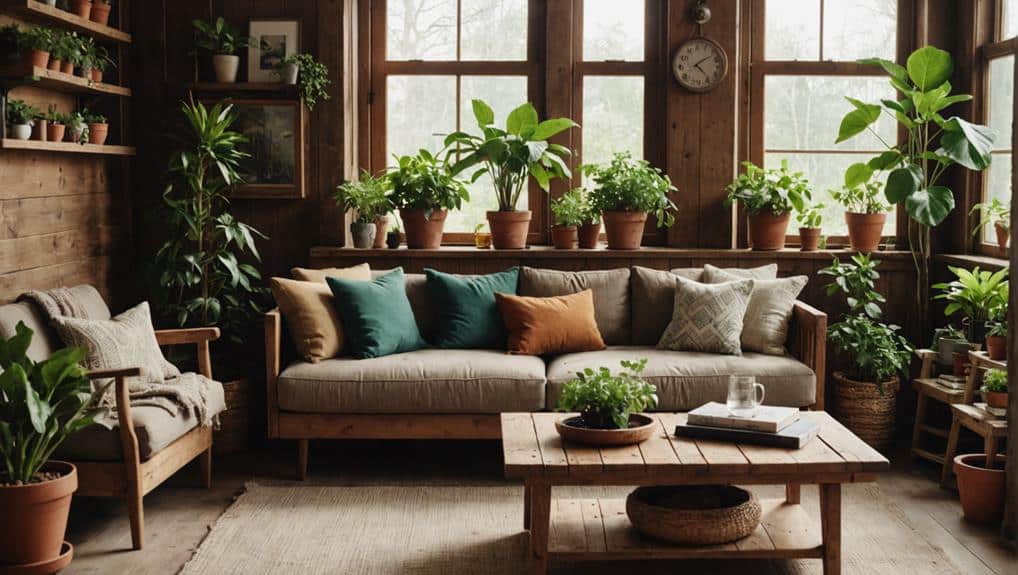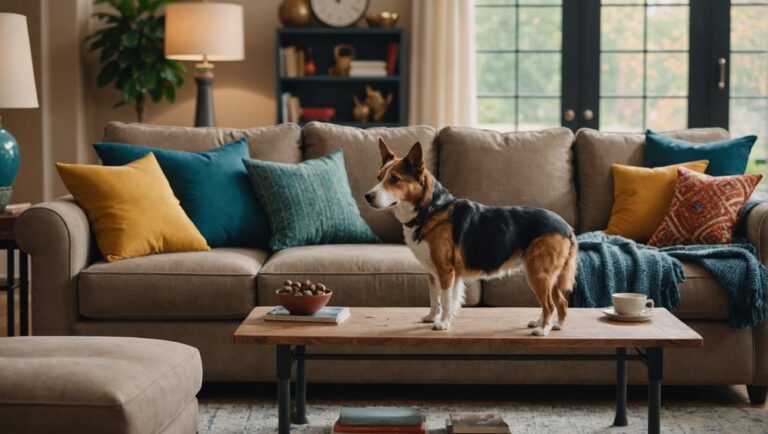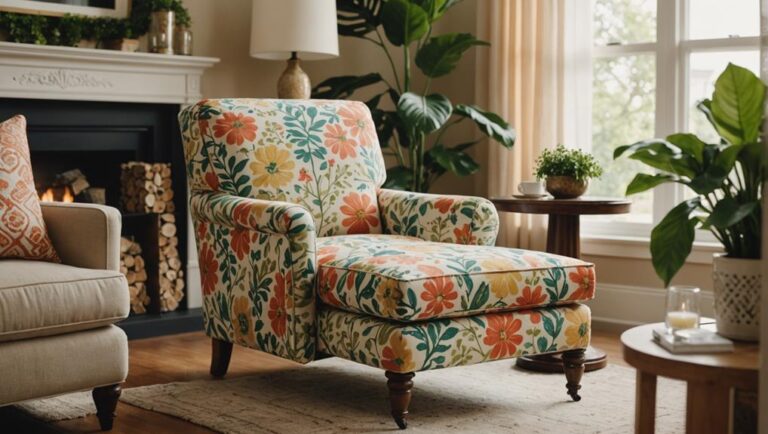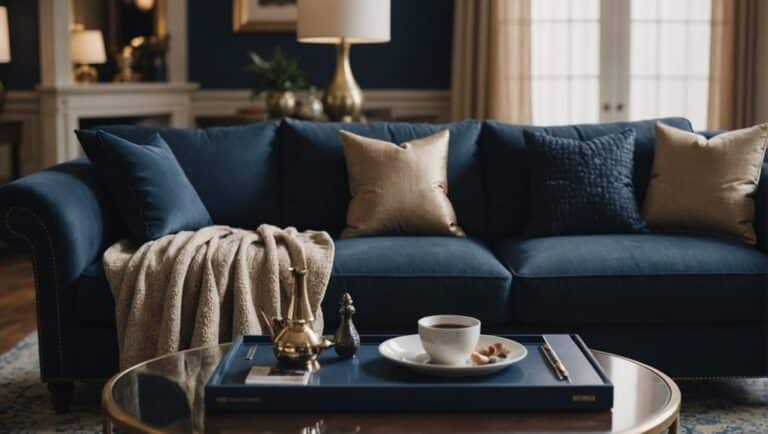At Chic Refuge, we believe that sustainable upholstery fabrics can significantly enhance your home while promoting environmental consciousness.
As experts in home decor, we're excited to share some excellent green choices with you.
Organic cotton is a fantastic option, known for its softness and being free from pesticides.
Hemp, on the other hand, boasts incredible durability and requires minimal water to grow, making it an eco-friendly powerhouse.
Linen is not only strong but also excels at managing moisture, perfect for various climates.
Meanwhile, bamboo fibers are both eco-friendly and naturally antimicrobial, providing an added layer of protection.
For those seeking innovative solutions, consider recycled polyester, which creatively transforms plastic waste into stylish fabrics.
Another remarkable choice is Tencel, derived from sustainably sourced wood pulp and fully biodegradable.
Each of these fabrics offers unique benefits that can complement your home's style.
Join us as we dive deeper into their features, helping you make informed choices for your living spaces that reflect both personal taste and environmental responsibility.
Key Takeaways
- Natural and organic fabrics like organic cotton and hemp are eco-friendly, produced without harmful pesticides, and support sustainable farming practices.
- Recycled polyester repurposes post-consumer plastic bottles, reducing landfill waste and energy consumption compared to virgin materials.
- Tencel, made from sustainably sourced wood pulp, features a closed-loop production process that minimizes waste and promotes responsible forestry.
- Bamboo fibers grow rapidly and require minimal resources, offering softness, durability, and antimicrobial properties for healthier living spaces.
- Wool, particularly Merino, is a biodegradable option that provides thermal regulation and stain resistance while ensuring ethical sourcing for animal welfare.
Organic Cotton
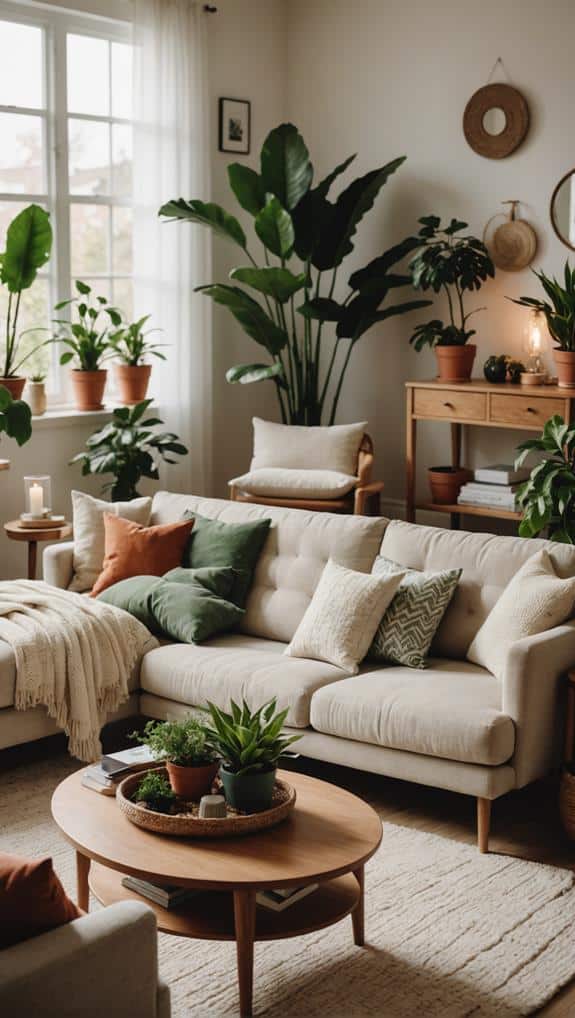
When we consider sustainable upholstery fabrics, organic cotton stands out as a top choice because it combines environmental benefits with comfort. This fabric isn't only soft and breathable but also produced without harmful pesticides, making it safer for both our families and the planet. Choosing organic cotton means we're supporting certified organic sources, which adhere to strict guidelines that promote sustainable farming.
Moreover, we can enjoy the richness of vibrant colors without compromising our values. By opting for upholstery dyed with organic dyeing techniques, we minimize harmful chemicals' impact. These methods utilize natural pigments extracted from plants, ensuring our upholstery is free from toxic residues that can be harmful to our health and the environment.
Using organic cotton in our home décor isn't just about aesthetics; it's a commitment to a cleaner, greener future. As we embrace this sustainable option, we're not only investing in durable and stylish pieces but also contributing to a system that supports ethical practices.
Hemp Fabric
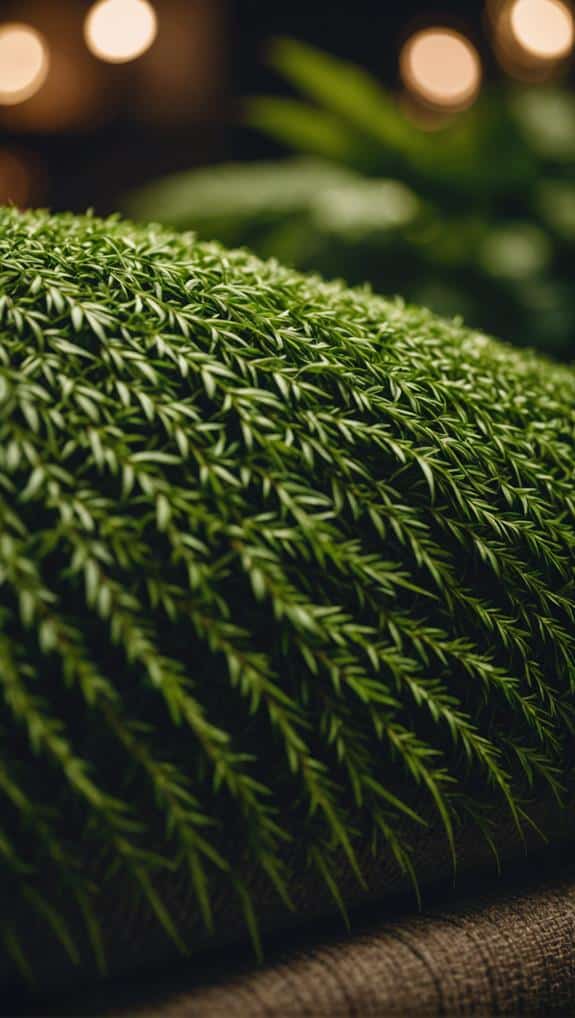
Moving from organic cotton, we find that hemp fabric is another standout option in sustainable upholstery. Hemp sustainability is an essential topic, as this versatile plant requires minimal water and no pesticides to grow.
It's not only eco-friendly, but also an excellent choice for those seeking durability in their upholstery fabrics.
Hemp fabric is remarkably strong and resistant to wear, making it ideal for furniture that sees frequent use. Its natural fibers have a unique ability to resist mildew and mold, contributing to a healthier indoor environment.
Additionally, hemp's breathability guarantees that your upholstery feels comfortable in various climates.
Another bonus is its long lifespan; with proper care, hemp upholstery can last for decades, outperforming many synthetic fabrics. This durability aligns perfectly with sustainable practices, as it reduces the need for frequent replacements, thereby minimizing waste.
When we choose hemp for our upholstery, we're not just making a stylish decision; we're actively contributing to a sustainable future.
With its blend of durability and environmental friendliness, hemp fabric stands out as a fantastic option for those looking to make responsible choices in their home decor.
Recycled Polyester
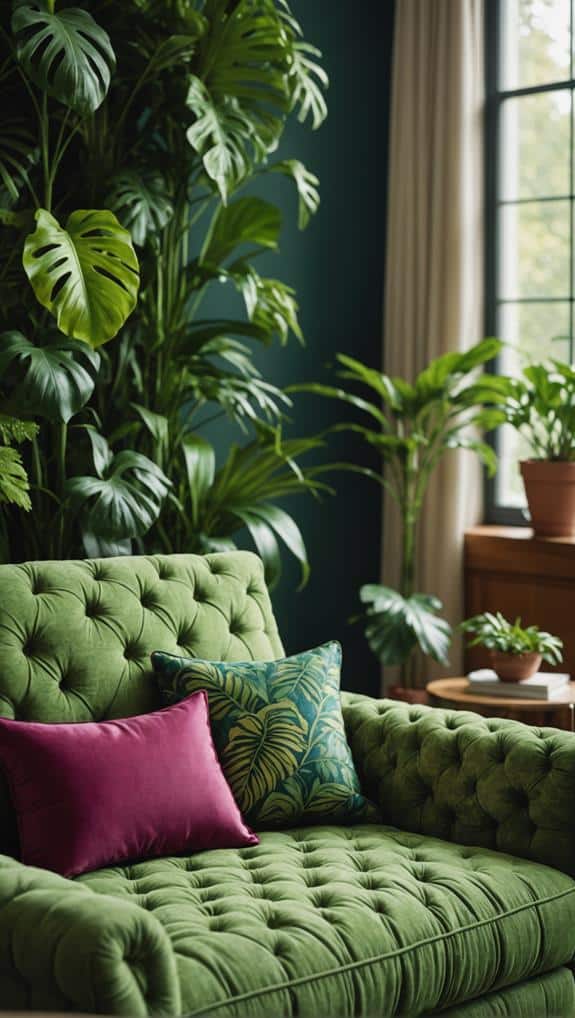
Although many may not realize it, recycled polyester is rapidly gaining traction as a sustainable upholstery fabric choice. Derived from post-consumer plastic bottles and other plastics, this innovative material transforms waste into stylish and durable fabrics. By opting for recycled polyester, we're not just selecting a visually appealing option but also greatly reducing our environmental impact.
One of the standout recycled benefits of this fabric is its ability to minimize landfill waste. Instead of letting plastics linger in our ecosystems, recycled polyester repurposes them, contributing to a circular economy. Additionally, producing recycled polyester consumes less energy and water than creating virgin polyester, further lowering its carbon footprint.
When we furnish our spaces with recycled polyester, we're also benefiting from its resilience and ease of maintenance. This fabric resists stains and fading, which means our upholstery can maintain its aesthetic appeal for years to come.
Linen Textiles

Linen textiles are quickly becoming a favorite choice for sustainable upholstery, thanks to their natural origin and impressive durability.
We love how these fabrics not only exude elegance but also stand up to daily wear and tear.
When we think of linen production, we recognize its low environmental impact compared to many other materials, making it a responsible choice for eco-conscious consumers.
Here are three key benefits of choosing linen for your upholstery needs:
- Linen Durability: Linen is one of the strongest natural fibers, ensuring that our upholstery can withstand the test of time without sacrificing style.
- Biodegradable: Unlike synthetic materials, linen breaks down naturally, reducing landfill waste.
- Natural Breathability: Linen has amazing moisture-wicking properties, helping to keep our living spaces comfortable and fresh.
Bamboo Fibers
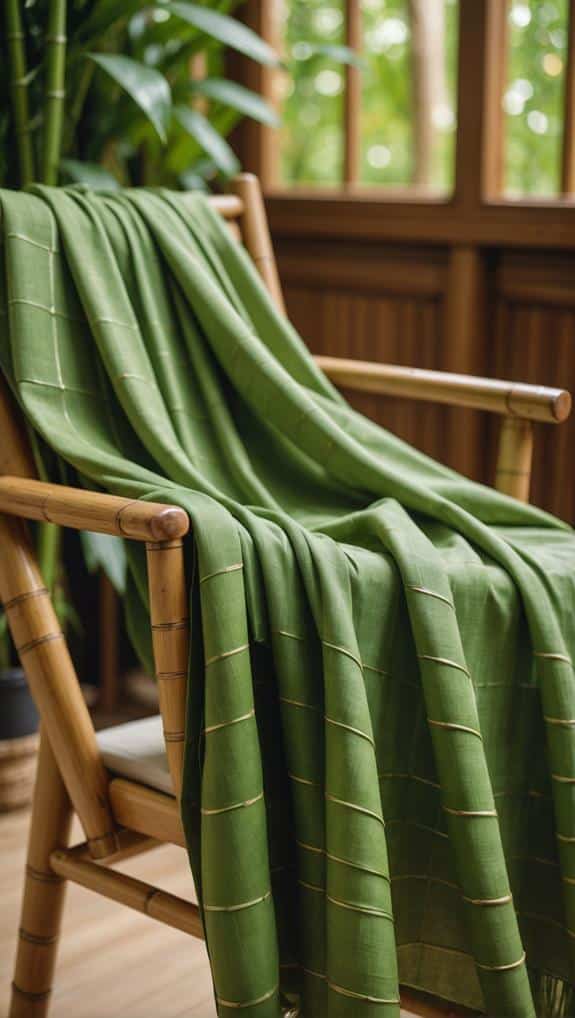
When exploring sustainable upholstery options, bamboo fibers stand out as another remarkable choice. Known for their inherent qualities, bamboo fibers exemplify both bamboo sustainability and durability. They grow rapidly, requiring minimal water and no pesticides, making them an environmentally friendly alternative to traditional fabrics.
In fact, bamboo can reach maturity in just three to five years, helping to reduce deforestation and greenhouse gas emissions.
When it comes to durability, we find bamboo fabrics are highly resilient, resisting wear and tear better than many other fibers. Their natural strength makes them ideal for upholstery that endures everyday use. Additionally, bamboo's antimicrobial properties help inhibit the growth of mold and bacteria, further enhancing its longevity in our homes.
Moreover, bamboo fabrics offer superior softness and comfort, making them a pleasure to incorporate into our living spaces. With options available in various textures and colors, they can easily blend into our existing decor while adding a fresh, eco-friendly touch.
Wool Options
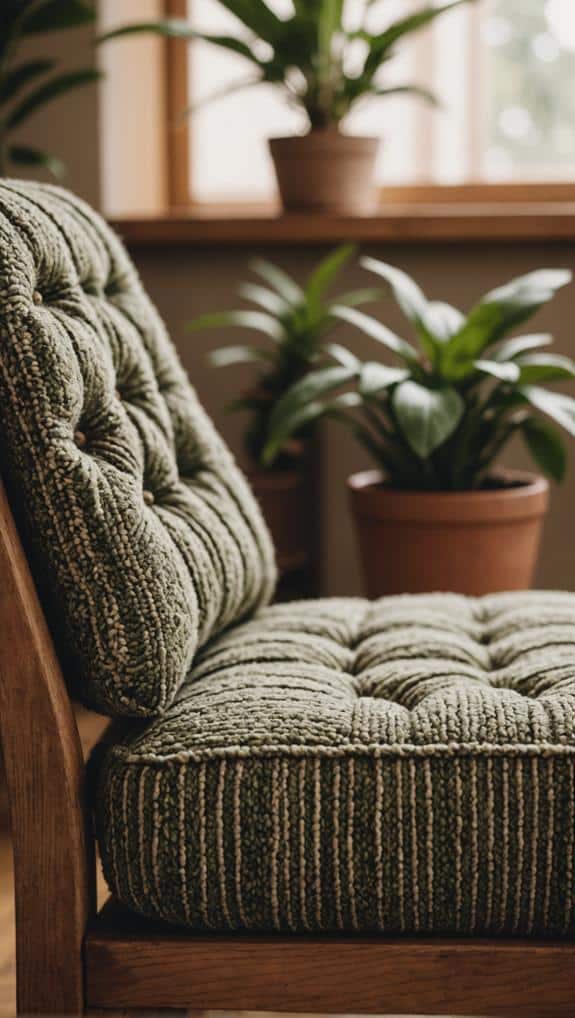
Exploring wool options for sustainable upholstery reveals a wealth of benefits that can elevate our living environments.
Merino wool, in particular, stands out as a luxurious choice that's both durable and sustainable. Not only does it look good, but it's also naturally resistant to stains, making it a practical option for our homes.
When considering wool sourcing, we should prioritize the following aspects:
- Ethical Sourcing: We need to guarantee our wool comes from farms that practice ethical animal husbandry. This means looking for certifications that ensure humane treatment of sheep.
- Biodegradability: Wool is a natural fiber that decomposes over time. Using wool upholstery helps us contribute to reducing landfill waste, as it doesn't contribute to the growing plastic problem.
- Thermal Regulation: Wool naturally regulates temperature, making it comfortable year-round. This quality adds to the overall coziness of our spaces and can even reduce energy costs.
Microfiber Alternatives
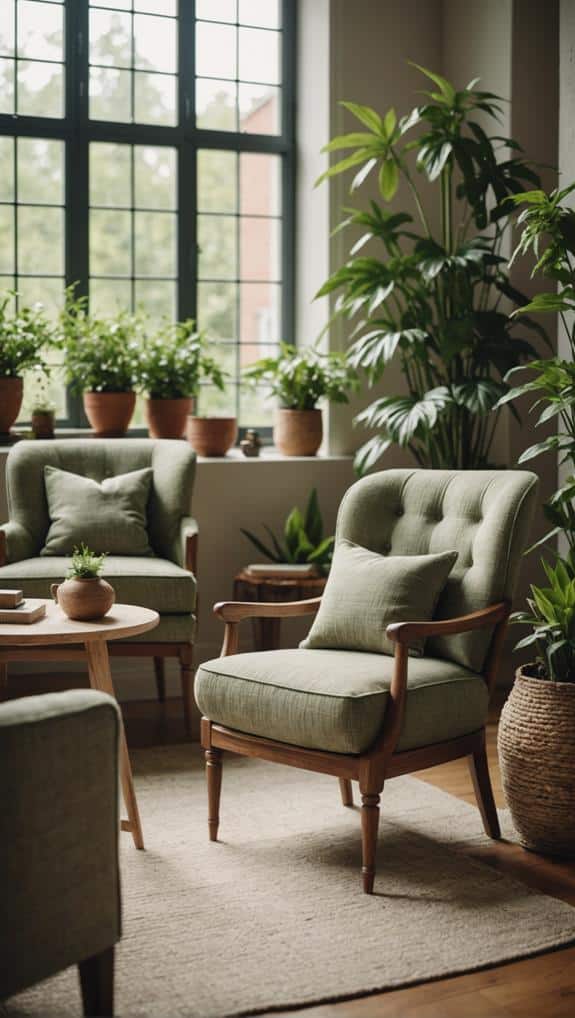
While wool offers remarkable benefits for sustainable upholstery, we also need to contemplate the potential of microfiber alternatives. These materials can provide a balance between durability and ecological responsibility. Microfiber, often derived from synthetic fibers, can be a concern due to its environmental impact.
However, advancements in microfiber sourcing mean we can find more eco-friendly options. By choosing microfiber alternatives made from recycled materials, we can reduce waste and minimize the depletion of natural resources. Companies focused on sustainable practices now offer these innovative fabrics, ensuring that our choices contribute positively to the environment.
It's not all about the material, though. The care we give our upholstery also plays a significant role. Opting for eco-friendly care solutions, such as biodegradable cleaning products, allows us to maintain our furniture without harming the planet.
When selecting microfiber alternatives, it's essential that we carefully evaluate the sources and manufacturing processes. We should look for transparency from brands regarding their environmental policies.
Tencel Products
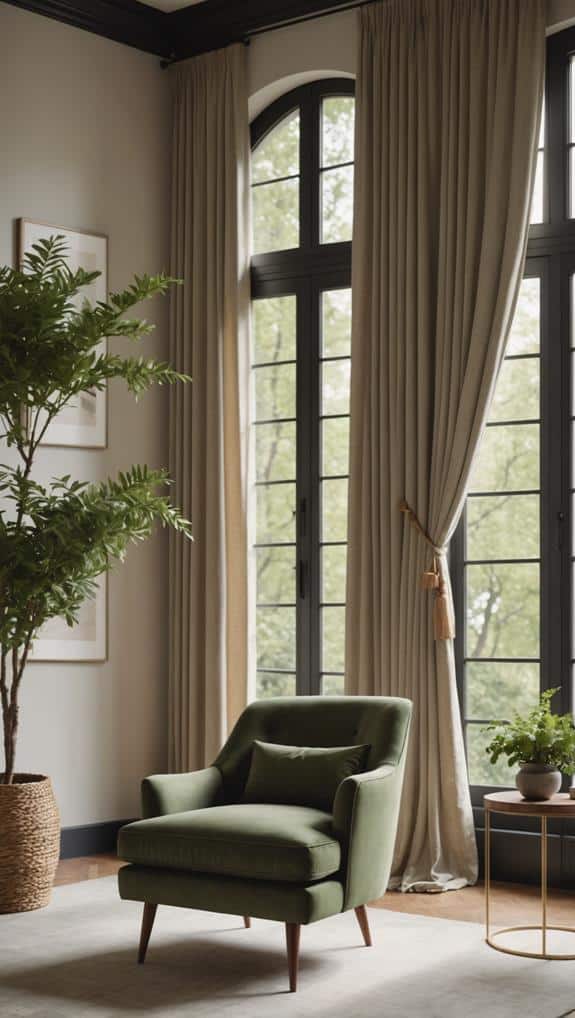
Tencel, a fiber made from sustainably sourced wood pulp, is revolutionizing the upholstery fabric market with its ecological benefits. As we seek out greener options, Tencel stands out due to its remarkable sustainability and responsible production methods.
It's not just another fabric; it's a choice that supports environmental well-being.
When we consider Tencel sustainability, we recognize its closed-loop production process, which recycles water and solvents, minimizing waste and environmental impact.
Here are three reasons why Tencel products are excellent choices for upholstery:
- Biodegradable: Tencel fibers decompose naturally, ensuring that they won't linger in landfills for decades.
- Moisture-Wicking: Tencel's ability to absorb moisture makes it resistant to bacteria, enhancing durability and comfort in any setting.
- Soft and Gentle: The fabric's silky texture not only looks appealing but also feels comfortable against the skin, making it suitable for both furniture and garments.
Incorporating Tencel into our upholstery choices aligns beautifully with our commitment to sustainability.
Frequently Asked Questions
Are Sustainable Upholstery Fabrics More Expensive Than Conventional Options?
When we look at sustainable upholstery fabrics, a cost comparison often shows they're pricier upfront. However, after conducting a value assessment, we realize their durability and eco-friendliness can save us money in the long run.
How Do I Care for Sustainable Upholstery Fabrics?
They say, "A stitch in time saves nine." We should practice proper fabric maintenance to keep our eco-friendly upholstery looking great. Using eco-friendly cleaning methods guarantees we preserve both beauty and sustainability for years.
Can Sustainable Fabrics Be Used for Outdoor Furniture?
We can enjoy sustainable fabrics for outdoor furniture. They often offer weather resistance and require eco-friendly maintenance, making them perfect choices for our outdoor spaces without compromising on style or environmental responsibility.
What Certifications Should I Look for in Sustainable Upholstery Fabrics?
When considering sustainable upholstery fabrics, we look for certifications like Global Organic Textile Standard and Oeko-Tex. These guarantee sustainable sourcing and eco-friendly options, giving us confidence in our choices for a greener living space.
Are There Specific Dyes Used in Sustainable Upholstery Fabrics?
When we consider sustainable upholstery fabrics, we're excited to find that eco-friendly dyes and natural pigmentation play a vital role. These choices not only enhance beauty but also minimize environmental impact, which we all appreciate.

